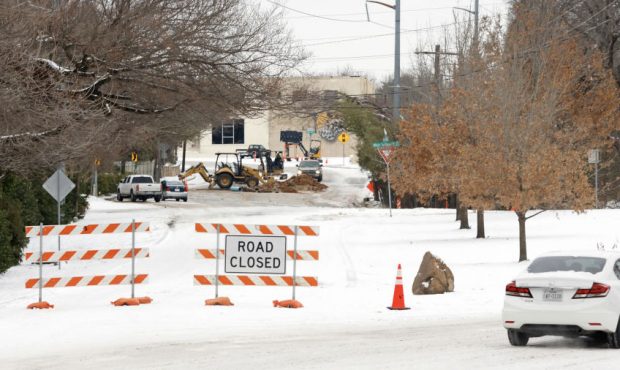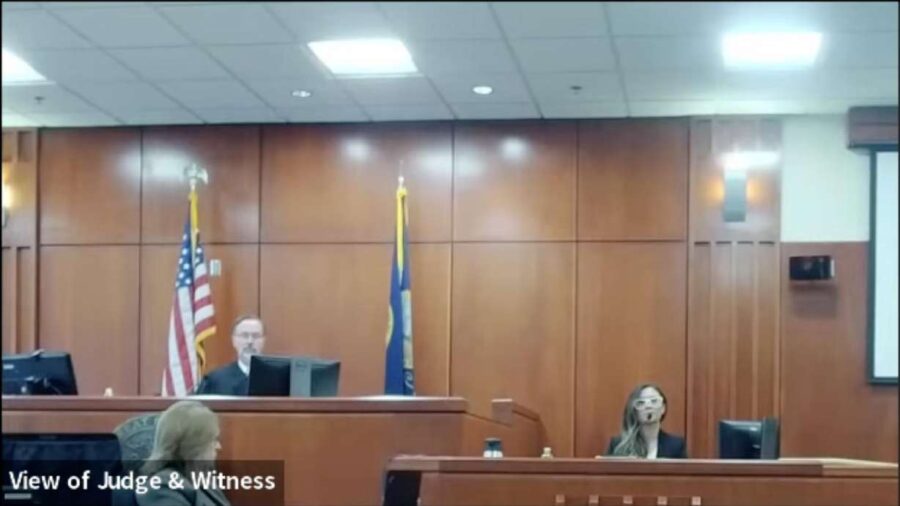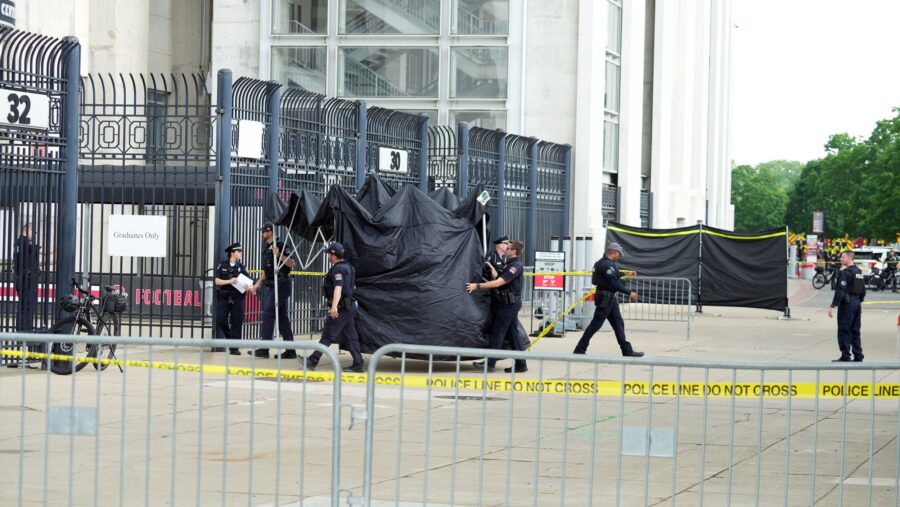Power Failure: How A Winter Storm Pushed Texas Into Crisis
Feb 21, 2021, 11:06 AM | Updated: 11:09 am

Drivers detour around a water pipe repair crew after a snow storm on February 18, 2021 in Fort Worth, Texas. Winter storm Uri has brought historic cold weather and power outages to Texas. Residents have gone days without electricity and fresh water after a catastrophic failure of the power grid in the state. (Photo by Ron Jenkins/Getty Images)
(Photo by Ron Jenkins/Getty Images)
HOUSTON (AP) — Two days before the storm began, Houston’s chief elected official warned her constituents to prepare as they would for a major hurricane. Many took heed: Texans who could stocked up on food and water, while nonprofits and government agencies set out to help those who couldn’t.
But few foresaw the fiasco that was to come. They could not be prepared.
As temperatures plunged and snow and ice whipped the state, much of Texas’ power grid collapsed, followed by its water systems. Tens of millions huddled in frigid homes that slowly grew colder or fled for safety. And a prideful state, long suspicious of regulation and outside help, was left to seek aid from other states and humanitarian groups as many of its 29 million people grasped for survival.
At one hospital, workers stood outside to collect rainwater. Others stood in line at a running tap in a park. A mother of three took her children to shelter in a furniture store after she could see her breath forming in the family’s trailer. University professors fundraised so their students could afford meals.
Images of desperate Texans circulated worldwide. To some, they evoked comparisons to a less wealthy or self-regarding place. To others, they laid bare problems that have long festered.
The state’s Republican leadership was blamed for ignoring warnings that winter could wreak the havoc that it did, and for not providing local officials with enough information to protect residents now.
A week after she warned her county’s nearly 5 million residents about the impending storm, Harris County Judge Lina Hidalgo was sleeping on an air mattress at the county’s emergency operations center. Her home was without power for three nights.
“It’s worth asking the question: Who set up this system and who perpetuated it knowing that the right regulation was not in place?” Hidalgo said. “Those questions are going to have to be asked and I hope that changes will come. The community deserves answers.”
___
Around 2 a.m. Monday, the full measure of the crisis Texas faced began to be apparent.
Cold and ice had set in the day before, leading to spreading power outages across the state. But standing in the emergency operations center early Monday, Hidalgo and others learned that their local energy provider, CenterPoint Energy, would not be able to “roll” outages between homes as they had been told earlier.
Instead of short intervals of heat, enough to keep their homes safe, residents would have to go without for days on end.
Most people did not yet know that Texas’ power grid had been on the brink of total failure. That revelation would come three days later.
Power outages spiraled through the day Monday, ultimately cutting off more than 4 million people. Grocery stores shut down, and hotel rates skyrocketed.
People who fled to the homes of relatives or neighbors had to consider the risks of contracting or spreading the coronavirus.
Ashley Archer and her husband decided to take in his best friend at their suburban Dallas home. She is pregnant and has been trying to protect herself from the virus for nearly a year.
The friend is “like family,” she said. “We weren’t going to let him freeze at his place.”
Things got worse Tuesday. Thousands of people sought refuge from their freezing homes in warming shelters. Others sat in their cars; hundreds were hospitalized for carbon monoxide poisoning. A woman and her young daughter died after running their car inside a garage. An 11-year-old boy was found dead after his family’s mobile home lost power.
In suburban Houston, Tina Rios could see her breath inside the trailer she shares with her husband and three children, ages 3, 9, and 10. She started “stressing really hard.” Her refuge was a Gallery Furniture store opened to a desperate public by a well-known Houston businessman, Jim “Mattress Mack” McIngvale.
At her Dallas condominium, 51-year-old Stephanie Murdoch layered in blankets, two pairs of pants, two sweaters, three pairs of socks, a hat, and gloves. Her anger grew at the power companies and their apparent lack of preparation.
“We’ve got another blast of snow coming in this evening … and still no clear answers as to why the grids aren’t working better,” she said.
By Wednesday, some started to get their power back, but a new shortage emerged — drinkable water.
Frozen pipes burst across the state. And the water that did come out of taps was often undrinkable due to dangerously low water pressure levels. At one point, an estimated 13 million people were under a boil-water order, nearly half of Texas’ population.
Along with her roommates in Austin, Abigail Burns, a 20-year-old university student, had filled bathtubs with water as experts advise before a storm. Austin instituted a boil-water order. But Burns’ apartment lacked the power to boil what they had.
After more than 80 hours without power and 24 hours without running water, they decided to brave icy roads, setting out for a friend’s home about 20 minutes away.
Methodist Hospital’s branch in far west Houston lost water, and hospital staff collected rainwater in carts so they could flush toilets. CEO Marc Boom said the hospital’s flagship location near downtown had turned a conference room into a staging area for dialysis patients.
“Many of those people end up not only needing dialysis but end up being admitted to the hospital,” Boom said. “There’s a lot of people who have medical devices at home, oxygen; all of those don’t work.”
More than 35 people in Texas have been confirmed dead. That number is expected to rise as roads cleared and relatives and first responders could check on missing loved ones.
Mark Henry, Galveston County’s judge, asked the state early in the week to send a refrigerated truck requested by the local medical examiner, who expected an influx of bodies.
“If they had been honest with us from the beginning, we would have ordered evacuations. But they didn’t tell us that,” he said. “What’s not manageable is to lose your power for days with a temperature in the single to double digits.”
___
How could this happen in a state that is the nation’s biggest energy producer and home to several of the world’s biggest energy companies?
The disaster can be traced to mistakes by Texas’ leadership and faults created by decades of opposition to more regulations and preparation.
Basically, the state is an island in the U.S. electrical system.
There is one large grid covering the Eastern half of the country, another for the West, with Texas wedged between them. There is a long and colorful history to how this came to be, but the simplest explanation is that Texas utilities wanted to be free of federal regulation. They accomplished that, going back to the middle of the last century, by avoiding sending power across state lines.
The Texas grid isn’t walled off, but there are only a few, small interconnection points with the Eastern U.S. grid and Mexico. In the past, utility executives have argued that the Texas grid would be less reliable and more vulnerable to blackouts if it were fully connected to the rest of the country – which would make it easier for other states to tap Texas during their own shortages.
The Electric Reliability Council of Texas, or ERCOT, was created in 1970; it became a more powerful broker over electricity flows after deregulation in this century. In the wake of the storm, it has taken most of the blame from Texas politicians and the public, losing trust with predictions that failed to capture the depth of the crisis and posting jargon-heavy tweets about power generation that were hard for anyone without a degree in engineering to decipher. Critics have noted some of ERCOT’s board does not live in Texas and that CEO, Bill Magness makes more than $800,000 a year.
Standing in Harris County’s emergency management center early Monday, Lina Hidalgo said she and other officials realized “that we couldn’t just take the words from ERCOT at face value.”
“They kept telling us that more power generation was coming online, only to send more orders to utilities to cut people off power,” she said Thursday.
Despite efforts by some Republicans to blame clean energy, the failures occurred in every part of the sector. While wind turbines and solar panels froze, a major nuclear plant lost half of its generation, and there were massive failures in coal, oil, and natural gas. Demand surged, meanwhile, as people accustomed to mild Texas winters turned on their heat.
In 2011, millions of Texans lost power during the Super Bowl, which was played in a Dallas suburb. Two agencies, the Federal Energy Regulatory Commission and the North American Electric Reliability Corporation, conducted a study on how Texas could “winterize” its energy infrastructure. At the highest end, winterizing 50,000 gas wells would cost an estimated $1.75 billion, the study found.
Of the 2011 storm, the report said: “Generators and natural gas producers suffered severe losses of capacity despite having received accurate forecasts of the storm. Entities in both categories report having winterization procedures in place. However, the poor performance of many of these generating units and wells suggests that these procedures were either inadequate or were not adequately followed.”
But there was no broad move to winterize equipment. Since then, bills requiring energy producers to hold more power in reserve or ordering a study of how to better prepare for winter failed in the Republican-controlled Texas House.
Texas lawmakers deregulated the energy market in 2002. Supporters say this lowered energy prices statewide, but critics say it gave producers leeway to avoid improvements that might have prevented events like this week’s catastrophe.
The energy industry remains a political powerhouse. More than $26 million of Republican Gov. Greg Abbott’s contributions have come from the oil and gas industry, more than any other economic sector, according to an analysis by the National Institute on Money in Politics.
In a Fox News interview, Abbott blamed this week’s fiasco on green energy — an assertion for which he was sharply criticized. At other points, Abbott did note failures across the energy industry. But others among the Republican leadership continued to tweet condemnations of green energy or support for natural gas.
Todd Staples, president of the Texas Oil & Gas Association, declined an interview request but issued a statement saying the industry was “steadfastly committed to doing our part to help Texas recover.”
Abbott has promised multiple investigations of this storm and made ERCOT an “emergency” item for the Legislature, which is currently in its biennial session.
“I think there is going to have to be a serious inquiry into why it was, what were the factors that led the grid not to be able to meet the energy needs of Texas,” said Republican U.S. Sen. Ted Cruz.
Cruz spoke Thursday evening in the yard of his home in one of Houston’s wealthiest neighborhoods, River Oaks. He had cut short a trip to Cancun, Mexico, after images circulated of him waiting at a Houston airport for his flight to the resort town.
Nearby, a group of protesters called on Cruz to resign.
___
At week’s end, as the cold weather began to loosen its grip, the power came back for most Texans. Bur the effects linger: Some Texans on variable-rate power contracts faced electric bills in the thousands of dollars, leading the governor to hold an emergency meeting Saturday with lawmakers.
There were dire shortages of drinking water. Cars lined up Friday for more than a mile in several directions to reach one water distribution site in northwest Houston, where volunteers were distributing two pallets of water bottles per vehicle.
Burst pipes had flooded thousands of homes. Earlier in the week, Abbott had asked plumbers from other states to come to Texas and help.
Fixing pipes is one thing. Fixing a whole state is another.
Extremes caused by global warming will make deadly weather more common. Hidalgo, the Harris County judge, said the state needs to overcome “the taboo of talking about climate change.”
It’s difficult to estimate how much it would cost for all the wintertime upgrades Texas needs, but the tab would likely be in the billions of dollars.
In California, long the foil of Texas Republicans, Pacific Gas and Electric is in the early stages of spending an estimated $40 billion to $50 billion upgrading its equipment to reduce the chances of igniting wildfires during hot and windy conditions that have become increasingly common during the late summer and early autumn.
Around the time Cruz was flying back from Cancun on Thursday, Joidice Slack waited in line at a west Houston park to fill up water from a running tap.
The 37-year-old market analyst lost power on Sunday, water on Monday. She carried two empty drums of water that she filled with a garden hose.
“Today would have been rough because we had about half of one of these and we were like, ’Let’s go start looking. Hopefully we find some more water,’” she said.
“This is where we are at right now.”
___
Associated Press journalists Jake Bleiberg and David Koenig in Dallas; Acacia Coronado and Paul J. Weber in Austin, Texas; Michael Liedtke in San Ramon, California; Juan A. Lozano in Houston; and Jamie Stengle in Dallas contributed to this report.













